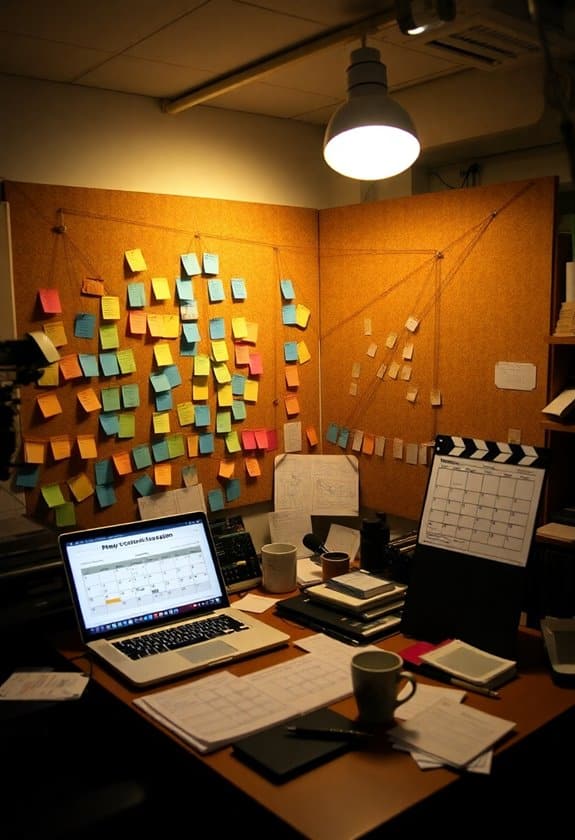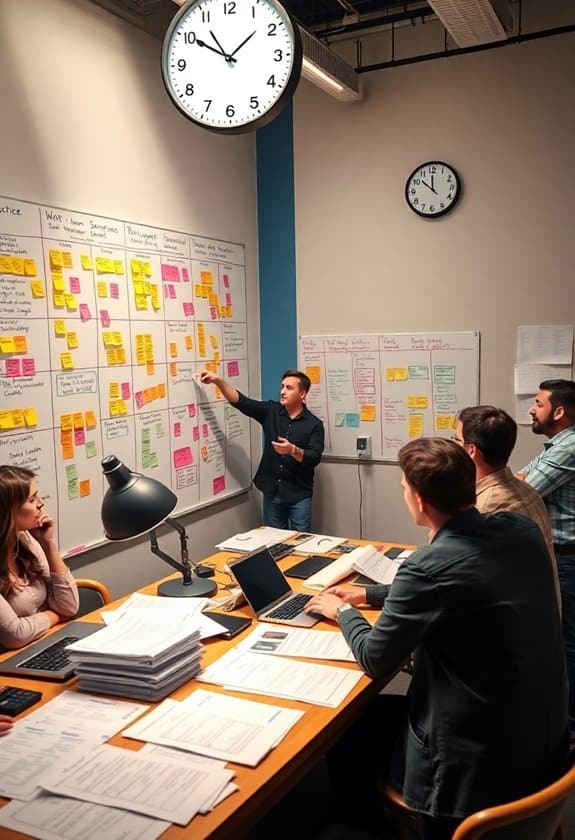Creating an effective film production schedule is like planning a giant puzzle, where every piece counts. Start by breaking your project into smaller tasks and allow some extra time for unexpected hiccups—trust me, they happen! I once called an outdoor shoot, only for it to rain buckets, thankful we had a backup day. It’s essential to coordinate with your team early to dodge scheduling conflicts and track their availability using handy tools. Set clear milestones and always keep a flexible mindset, so you can adapt to sudden changes. Remember, the more prepared you are, the smoother your filmmaking journey will be.
Important Highlights
- Break projects into smaller tasks to enhance focus and manageability.
- Allocate extra time for unforeseen issues to maintain flexibility and reduce stress.
- Establish clear milestones to monitor progress and maintain production focus.
- Ensure early communication with the team to coordinate schedules and avoid conflicts.
- Regularly update the schedule to keep it relevant and accommodate changes effectively.
Understanding Film Production Phases

Grasping the different phases of film production is essential for crafting a realistic and efficient schedule.
You start with pre-production, where the magic begins. Think of it as planning the safest adventure ever. You’ll gather your team, secure locations, and make sure everyone knows their role. It’s like organizing a party where everyone gets home safely, with no surprises.
Next comes production, the heart of filmmaking. Here, you capture every scene, ensuring everyone’s on the same page.
It’s like rehearsing a play, but with cameras. You want clear communication so nobody trips over a cable—trust me, it happens! Additionally, having the right essential filmmaking equipment can significantly enhance your production efficiency and organization.
Setting Realistic Timelines

Here are some tips to help you set timelines that work:
- Break it down: Divide the project into smaller, manageable parts. Remember that even a superhero needs to tackle one villain at a time!
- Pad your schedule: Always add extra time for unforeseen hiccups. It’s like carrying an umbrella; better safe than sorry!
- Communicate: Keep everyone in the loop. A well-informed crew is a safe and happy crew.
- Consider equipment needs: Make sure to schedule time for acquiring and testing essential gear like tripod stability features to ensure smooth filming days.
Budgeting for Time and Resources

Budgeting for time and resources is essential to keeping your film project on track and within financial limits. Imagine your film as a puzzle; each piece represents time, money, and effort. You’ve got to fit them together just right.
Start by listing all the necessary resources like equipment, locations, and crew. Think of it like packing for a camping trip—bring everything you need, but don’t overload the backpack.
You’ll want to allocate time smartly, ensuring you’ve got enough for each scene without rushing. Remember, quality over speed! It’s easy to underestimate the time needed, but planning carefully keeps surprises at bay and everyone safe.
A well-prepared schedule lets you focus on creativity, knowing you’ve got a solid plan backing you up. Additionally, investing in affordable filmmaking gear can help you maximize your budget while ensuring you have the right tools for the job.
Identifying Key Milestones

To keep your film production on track, identifying key milestones is essential. Think of these milestones like checkpoints in a video game—each one gets you closer to the big finale without straying off course.
From my experience, knowing what needs to happen when guarantees everyone’s on the same page, and nobody ends up filming a summer scene in a snowstorm!
Here’s a quick list of critical milestones you should focus on:
- Script Finalization: Before anything else, make sure your script is polished and ready to go. This sets the stage for everything that follows.
- Casting Completion: Secure your actors early to avoid last-minute scrambles.
- Location Scouting: Lock in your filming locations to guarantee safety and logistical clarity.
Keep these milestones in mind, and you’ll be well-prepared!
Prioritizing Essential Tasks

Now that you’ve pinpointed your key milestones, let’s focus on prioritizing essential tasks to guarantee a smooth production process.
Imagine this: you’re on set, and suddenly, you realize the costumes aren’t ready. Yikes! To avoid such hiccups, make a list of tasks that absolutely need to happen first. Think about everything from securing locations to finalizing scripts. Organize them by urgency and impact.
Remember, safety first! Double-check that all essential equipment is in top shape and verify permits are in place. It’s like assembling a puzzle; each piece must fit perfectly.
But don’t stress too much—prioritizing is like having a trusty map on a treasure hunt. Keep calm, and stay organized, and your filmmaking journey will be a safe and successful adventure!
Coordinating Team Availability

Ensuring your team is available when needed is essential for a smooth production flow. Imagine gathering everyone, only to find your key grip is stuck in traffic or your lead actor’s double-booked!
Here’s how you can avoid those hiccups:
- Communicate Early and Often: Start by discussing everyone’s schedules way in advance. It’s like planning a big sleepover; you need everyone’s buy-in!
- Be Flexible: Life happens, and sometimes folks have unexpected commitments. Keep a backup plan handy, like having a substitute or alternate day.
- Consider Time Zones: If your team’s scattered across different zones, find a sweet spot that’s safe and fair for everyone. Think of it like a global family meeting.
Utilizing Scheduling Software

How can you streamline the chaos of scheduling in film production? Use scheduling software! It’s like having a digital assistant that guarantees everyone’s on the same page.
Imagine you’re trying to coordinate a large cast and crew without it—yikes! Scheduling software helps you avoid that nightmare by organizing shoot dates, locations, and team availability in one safe place.
You can easily update the schedule, and everyone gets notified instantly. This keeps communication clear and reduces the risk of misunderstandings.
Remember when I forgot to schedule a key scene? With software, that’s less likely to happen. It’s like a cozy safety net for your project.
Planning for Contingencies

When things go awry on a film set, having a plan B can save the day. Trust me, I’ve been there, staring at the sky as dark clouds rolled in.
A good contingency plan is like a superhero cape; it keeps you safe and ready for anything. Here’s what you can do:
- Have Backup Locations: Sometimes, your perfect spot gets rained out or becomes unavailable. Knowing where else you can shoot keeps the show rolling.
- Schedule Buffer Time: Build extra time into your schedule so that if something runs long, you won’t feel rushed or stressed.
- Prepare Alternative Equipment: Cameras and lights can fail. Having spares guarantees you don’t miss a shot. Consider keeping lightweight and portable options like the Etekcity 5-in-1 Reflector for versatility in lighting solutions.
Planning for the unexpected keeps everyone safe and your project on track!
Communicating the Schedule

A well-laid contingency plan is only as effective as the crew’s understanding of it, which brings us to the importance of communicating the schedule clearly.
Imagine you’re on set, and everyone knows the plan like it’s a secret recipe—each step is vital! Sharing the schedule isn’t just about handing over a spreadsheet; it’s about ensuring everyone feels safe and prepared.
Use apps or digital platforms to keep everyone in the loop, and don’t forget those good old-fashioned team meetings. Chat with your crew, answer questions, and encourage everyone to share their thoughts.
I remember a shoot where a simple miscommunication led to chaos, like a comedy of errors! Keeping communication open and clear helps everyone stay on the same page and safe.
Reviewing and Adjusting Regularly

To keep your film production on track, regularly reviewing and adjusting the schedule is essential.
Think of it like checking your map during a road trip. You wouldn’t want to end up in the middle of nowhere, right?
Here are three steps to help you stay safe and sound:
- Weekly Check-Ins: Gather your team, and chat about what’s working and what’s not. It’s like a mini family meeting!
- Flexibility is Key: Be ready to shuffle things around. Weather changes, actors get sick, and sometimes, a cat walks onto your set (true story!).
- Seek Feedback: Ask your crew for suggestions. They might see a path you didn’t notice.
Frequently Asked Questions
How Do You Handle Unexpected Weather Conditions Affecting Outdoor Shoots?
When the weather decides to play Pong with your outdoor shoot, it’s best to have a backup plan.
Always check forecasts and have indoor locations ready, like a trusty Plan B—think of it as your filmmaking umbrella. Keep safety gear handy, from raincoats to sunscreen.
Having a flexible schedule helps; maybe you’ll film a sunny scene indoors instead.
Once, a sudden downpour turned our shoot into a splashy comedy, but we laughed it off!
What Are the Best Practices for Managing Overlapping Film Projects?
Balancing overlapping film projects can feel like juggling flaming torches, but don’t worry, you’re not alone in this circus!
Prioritize tasks by creating a clear timeline for each project, and communicate with your team to avoid burnout.
Use digital tools to keep everything organized, and remember, it’s okay to say no sometimes.
Trust your instincts and rely on your experiences to guide decisions.
Stay flexible, and don’t forget to breathe!
You’re doing great.
How Can Time Zone Differences Impact International Film Production Scheduling?
Imagine time zones as invisible rivers, sometimes creating gentle streams or turbulent rapids in your film’s journey.
When you’re coordinating international shoots, these time shifts can feel like a game of telephone gone wrong. Remember that 3 AM call that made you feel like a nocturnal creature?
Planning ahead and respecting everyone’s clock guarantees safety and smooth sailing. Use shared calendars and set clear deadlines; you’ll navigate these waters confidently.
What Strategies Help in Minimizing Delays Caused by Equipment Malfunctions?
When you’re filming, equipment malfunctions can really throw a wrench in things! To minimize delays, always have backup gear on set.
Think of it like having extra pencils during a test—better safe than sorry! Regular maintenance checks are key, too, ensuring everything’s in tip-top shape.
And don’t forget to train your team on troubleshooting basics. Trust me, it saves time and keeps the show rolling smoothly, like a well-oiled machine!
How Do You Ensure Compliance With Labor Laws in Scheduling?
Imagine your film set as a bustling city where everyone has a role, and the clock is your best friend. To guarantee labor law compliance, you’ve got to balance work hours like a pro juggler, respecting break times and max hours.
Picture yourself checking off each task while chatting with your team about their needs. Remember, keeping your crew happy and healthy means fewer hiccups and more magic on screen.




